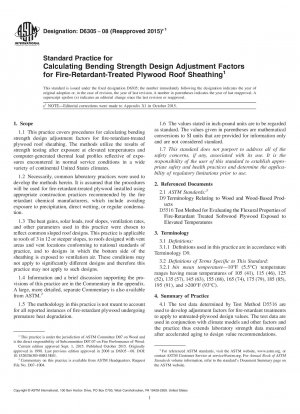ASTM D6305-08(2015)e1
Standard Practice for Calculating Bending Strength Design Adjustment Factors for Fire-Retardant-Treated Plywood Roof Sheathing
- Standard No.
- ASTM D6305-08(2015)e1
- Release Date
- 2008
- Published By
- American Society for Testing and Materials (ASTM)
- Status
- Replace By
- ASTM D6305-21
- Latest
- ASTM D6305-21
- Scope
5.1 This practice develops treatment factors that shall be used by fire retardant chemical manufacturers to adjust bending strength design values for untreated plywood to account for the fire-retardant treatment effects. This practice uses data from reference thermal-load cycles designed to simulate temperatures in sloped roofs of common design to evaluate products for 50 iterations.
5.2 This practice applies to material installed using construction practices recommended by the fire retardant chemical manufacturers that include avoiding exposure to precipitation, direct wetting, or regular condensation. This practice is not meant to apply to buildings with significantly different designs than those described in 1.3.
5.3 Test Method D5516 caused thermally induced strength losses in laboratory simulations within a reasonably short period. The environmental conditions used in the laboratory-activated chemical reactions that are considered to be similar to those occurring in the field. This assumption is the fundamental basis of this practice.
1.1 This practice covers procedures for calculating bending strength design adjustment factors for fire-retardant-treated plywood roof sheathing. The methods utilize the results of strength testing after exposure at elevated temperatures and computer-generated thermal load profiles reflective of exposures encountered in normal service conditions in a wide variety of continental United States climates.
1.2 Necessarily, common laboratory practices were used to develop the methods herein. It is assumed that the procedures will be used for fire-retardant-treated plywood installed using appropriate construction practices recommended by the fire retardant chemical manufacturers, which include avoiding exposure to precipitation, direct wetting, or regular condensation.
1.3 The heat gains, solar loads, roof slopes, ventilation rates, and other parameters used in this practice were chosen to reflect common sloped roof designs. This practice is applicable to roofs of 3 in 12 or steeper slopes, to roofs designed with vent areas and vent locations conforming to national standards of practice, and to designs in which the bottom side of the sheathing is exposed to ventilation air. These conditions may not apply to significantly different designs and therefore this practice may not apply to such designs.
1.4 Information and a brief discussion supporting the provisions of this practice are in the Commentary in the appendix. A large, more detailed, separate Commentary is also available from ASTM.2
1.5 The methodology in this practice is not meant to account for all reported instances of fire-retardant plywood undergoing premature heat degradation.
1.6 The values stated in inch-pound units are to be regarded as standard. The values given in parentheses are mathematical conversions to SI units that are provided for information only and are not considered standard......
ASTM D6305-08(2015)e1 Referenced Document
- ASTM D5516 Standard Test Method for Evaluating the Flexural Properties of Fire-Retardant Treated Softwood Plywood Exposed to Elevated Temperatures
- ASTM D9 Standard Terminology Relating to Wood
ASTM D6305-08(2015)e1 history
- 2021 ASTM D6305-21 Standard Practice for Calculating Bending Strength Design Adjustment Factors for Fire-Retardant-Treated Plywood Roof Sheathing
- 2008 ASTM D6305-08(2015)e1 Standard Practice for Calculating Bending Strength Design Adjustment Factors for Fire-Retardant-Treated Plywood Roof Sheathing
- 2008 ASTM D6305-08 Standard Practice for Calculating Bending Strength Design Adjustment Factors for Fire-Retardant-Treated Plywood Roof Sheathing
- 2002 ASTM D6305-02e1 Standard Practice for Calculating Bending Strength Design Adjustment Factors for Fire-Retardant-Treated Plywood Roof Sheathing
- 2002 ASTM D6305-02 Standard Practice for Calculating Bending Strength Design Adjustment Factors for Fire-Retardant-Treated Plywood Roof Sheathing
- 1998 ASTM D6305-98e1 Standard Practice for Calculating Bending Strength Design Adjustment Factors for Fire-Retardant-Treated Plywood Roof Sheathing

Copyright ©2024 All Rights Reserved